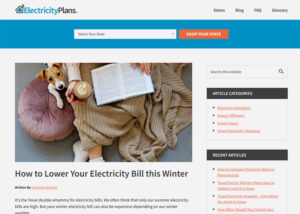Article by Shannon Bedrich, posted on Electricity Plans

How to Lower Your Electricity Bill this Winter (electricityplans.com)
It’s the Texas double whammy for electricity bills. We often think that only our summer electricity bills are high. But your winter electricity bill can also be expensive depending on our winter weather.
The reality is, 60% of Texans use electricity to heat their homes. And even if you’re among the 35% that heat with natural gas, you’ll use power to control the thermostat and igniter, and to blow the heat around your house. Here are tips on how to reduce your winter electricity bill, plus how to properly size a space heater for your room.
10 Ways to Save on Your Electricity Bill This Winter
Saving on your winter electricity bill is similar to the ways to save on your summer electricity. Focus on conservation and keeping your home air tight.
1. Weatherstrip Doors & Windows
Try the dollar bill test to see if you need weatherstripping around your doors and windows. Place a dollar bill in the closed door or window. If you can easily pull it out? You don’t have a tight seal and cold air can come into your home.
2. Upgrade to a Smart Thermostat
A smart thermostat can learn your patterns and automatically adjust heating and cooling to reach a set point. Plus you can manage it remotely, which is helpful if you participate in an electricity plan with energy saving rewards.
3. Keep Air Vents Open
The running debate in homes across America. Should you shut the air vents in unused rooms or leave them open? After all, it doesn’t make sense to heat an empty room. Or does it? Your central heating system is designed to flow across all those vents. Shutting a vent can cause increased air pressure in your ventilation system. That can cause holes or cracks in your ductwork. Better to leave all the vents open.
4. Add Insulation
Insulation degrades over time. If it’s been a while since you’ve refreshed your insulation, consider adding more before the winter. A good rule of thumb: If you can see the floor beams in your attic, you need more insulation.
5. Install an Attic Tent
An attic tent will insulate the attic access door from the rest of your home. That keeps cold air in the attic, where it belongs, and warm air in your home.
6. Keep the Fireplace Closed
Many modern homes have a gas or electric fireplace that can turn on with the flick of a switch. If you have a traditional wood fireplace, limit the number of fires to special occasions only. And be sure to close the damper, or flue, after you use it. Approximately 80% of the heat from your fireplace goes right out the chimney. And if you leave the flue open, you’re just letting the heat from your home escape.
7. Insulate Your Water Heater
If you have electric heat in your home, chances are you also have an electric water heater. If your water heater is in a non-insulated area of your home, like your garage or attic, wrap it up! The cold air makes your water heater work overtime to maintain hot water on demand. Purchase a water heater blanket online or at any hardware store.
8. Seal Outside-Facing Baseboards
Improper seals around your baseboards can let cold air in. Apply clear caulk along the edge where the wall and floor meet, on the outside walls of your home.
9. Dress for the Weather
What your mother always said is true. If you’re cold, put a sweater on. Set your thermostat at 68° and dress for the season to save on your winter heating bill.
10. Use Heat and Light from Sunshine
Bright sunshine on a cold day can warm up your home, especially in rooms with a southern exposure. Just make sure to shut the blinds or curtains at night. That lets you make use of sunshine during the day and get the insulating benefits of your curtains at night.
And make sure you aren’t on an off-contract electricity rate going into winter. If you’re on a month to month electricity rate, you’ll pay a market rate. Check current electricity rates and lock in a fixed rate plan.
Click here to read the entire original article posted on Electricity Plans.





